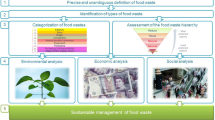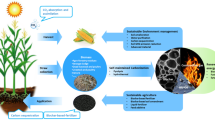Abstract
Variations of physical and chemical characteristics of biomass reduce equipment utilization and increase operational costs of biomass processing. Biomass processing facilities use sensors to monitor the changes in biomass characteristics. Integrating sensory data into the operational decisions in biomass processing will increase its flexibility to the changing biomass conditions. In this paper, we propose a multi-stage stochastic programming model that minimizes the expected operational costs by identifying the inventory level and creating an operational decision policy for equipment speed settings. These policies take the sensory information data and the current biomass inventory level as inputs to dynamically adjust inventory levels and equipment settings according to the changes in the biomass’ characteristics. We ensure that a prescribed target reactor utilization is consistently achieved by penalizing the violation of the target reactor feeding rate. A case study is developed using real-world data collected at Idaho National Laboratory’s biomass processing facility. We show the value of multi-stage stochastic programming from an extensive computational experiment. Our sensitivity analysis indicates that updating the infeed rate of the system, the processing speed of equipment, and bale sequencing based on the moisture level of biomass improves the processing rate of the reactor and reduces operating costs.





Similar content being viewed by others
References
Frank, A.G., Dalenogare, L.S., Ayala, N.F.: Industry 4.0 technologies: Implementation patterns in manufacturing companies. Int. J. Prod. Econ. 210, 15–26 (2019). https://doi.org/10.1016/j.ijpe.2019.01.004
Dalenogare, L.S., Benitez, G.B., Ayala, N.F., Frank, A.G.: The expected contribution of industry 4.0 technologies for industrial performance. Int. J. Prod. Econ. 204, 383–394 (2018). https://doi.org/10.1016/j.ijpe.2018.08.019
Snetterton Renewable Energy Plant: Behind the project. https://www.snettertonbiomass.com/behind-the-project/. Accessed: 2021-06-25 (2015)
Birge, J.R.: Aggregation bounds in stochastic linear programming. Math. Progr. 31(1), 25–41 (1985)
Domac, J., Richards, K., Risovic, S.: Socio-economic drivers in implementing bioenergy projects. Biomass Bioenerg. 28(2), 97–106 (2005). https://doi.org/10.1016/j.biombioe.2004.08.002
Sims, R.: Bioenergy to mitigate for climate change and meet the needs of society, the economy and the environment. Mitig. Adapt. Strat. Glob. Change 8(4), 349–370 (2003)
You, F., Tao, L., Graziano, D.J., Snyder, S.W.: Optimal design of sustainable cellulosic biofuel supply chains: Multiobjective optimization coupled with life cycle assessment and input-output analysis. AIChE Journal 58(4), 1157–1180 (2012) https://aiche.onlinelibrary.wiley.com/doi/pdf/10.1002/aic.12637. https://doi.org/10.1002/aic.12637
Bhattacharya, A., Kharoufeh, J.P., Zeng, B.: Managing energy storage in microgrids: A multistage stochastic programming approach. IEEE Trans. Smart Grid 9(1), 483–496 (2018)
de Matos, V.L., Morton, D., Finardi, E.C.: Assessing policy quality in a multistage stochastic program for long-term hydrothermal scheduling. Ann. Oper. Res. 253(2), 713–731 (2017). https://doi.org/10.1007/s10479-016-2107-6
Bruno, S., Ahmed, S., Shapiro, A., Street, A.: Risk neutral and risk averse approaches to multistage renewable investment planning under uncertainty. Eur. J. Oper. Res. 250(3), 979–989 (2016). https://doi.org/10.1016/j.ejor.2015.10.013
Siddig, M., Song, Y.: Adaptive partition-based sddp algorithms for multistage stochastic linear programming with fixed recourse. Comput. Optim. Appl. 81(1), 201–250 (2022)
Cariño, D.R., Kent, T., Myers, D.H., Stacy, C., Sylvanus, M., Turner, A.L., Watanabe, K., Ziemba, W.T.: The russell-yasuda kasai model: An asset/liability model for a japanese insurance company using multistage stochastic programming. INFORMS J. Appl. Anal. 24(1), 29–49 (1994). https://doi.org/10.1287/inte.24.1.29
Steinbach, M.C.: Recursive direct algorithms for multistage stochastic programs in financial engineering. In: Operations Research Proceedings 1998, pp. 241–250. Springer, Berlin (1999)
Gulpinar, N., Rustem, B., Settergren, R.: Multistage stochastic programming in computational finance. In: Computational Methods in Decision-Making, Economics and Finance, pp. 35–47. Springer, Berlin (2002)
Dupačová, J.: Portfolio Optimization and Risk Management Via Stochastic Programming. Osaka University Publishing Co., Osaka (2009)
Ahmed, S., Sahinidis, N.V.: An approximation scheme for stochastic integer programs arising in capacity expansion. Oper. Res. 51(3), 461–471 (2003). https://doi.org/10.1287/opre.51.3.461.14960
Chen, Z., Li, S., Tirupati, D.: A scenario-based stochastic programming approach for technology and capacity planning. Comput. Oper. Res. 29(7), 781–806 (2002). https://doi.org/10.1016/S0305-0548(00)00076-9
Gupta, V., Grossmann, I.E.: Multistage stochastic programming approach for offshore oilfield infrastructure planning under production sharing agreements and endogenous uncertainties. J. Petrol. Sci. Eng. 124, 180–197 (2014). https://doi.org/10.1016/j.petrol.2014.10.006
Singh, K.J., Philpott, A.B., Wood, R.K.: Dantzig-wolfe decomposition for solving multistage stochastic capacity-planning problems. Oper. Res. 57(5), 1271–1286 (2009). https://doi.org/10.1287/opre.1080.0678
Alonso, A., Escudero, L.F., Teresa Ortuño, M.: A stochastic 0–1 program based approach for the air traffic flow management problem. Eur. J. Oper. Res. 120(1), 47–62 (2000). https://doi.org/10.1016/S0377-2217(98)00381-6
Herer, Y.T., Tzur, M., Yücesan, E.: The multilocation transshipment problem. IIE Trans. 38(3), 185–200 (2006). https://doi.org/10.1080/07408170500434539
Möller, A., Römisch, W., Weber, K.: Airline network revenue management by multistage stochastic programming. CMS 5(4), 355–377 (2008)
Birge, J.R., Louveaux, F.: Introduction to Stochastic Programming. Springer, New York (2011)
Shapiro, A., Nemirovski, A.: On Complexity of Stochastic Programming Problems, pp. 111–146. Springer, Boston (2005). https://doi.org/10.1007/0-387-26771-9_4
Birge, J.R.: Decomposition and partitioning methods for multistage stochastic linear programs. Oper. Res. 33(5), 989–1007 (1985)
Pereira, M.V.F., Pinto, L.M.V.G.: Multi-stage stochastic optimization applied to energy planning. Math. Program. 52(2), 359–375 (1991)
Shapiro, A.: Analysis of stochastic dual dynamic programming method. Eur. J. Oper. Res. 209, 63–72 (2011)
Powell, W.B.: A unified framework for stochastic optimization. Eur. J. Oper. Res. 275(3), 795–821 (2019)
Huang, K., Ahmed, S.: The value of multistage stochastic programming in capacity planning under uncertainty. Oper. Res. 57(4), 893–904 (2009)
Xie, F., Huang, Y.: A multistage stochastic programming model for a multi-period strategic expansion of biofuel supply chain under evolving uncertainties. Transp. Res. Part E: Logist. Transp. Rev. 111, 130–148 (2018). https://doi.org/10.1016/j.tre.2018.01.015
Mahmutoǧullar, A.I., Ahmed, S., Çavuş, Ö., Aktürk, M.S.: The value of multi-stage stochastic programming in risk-averse unit commitment under uncertainty. IEEE Trans. Power Syst. 34(5), 3667–3676 (2019). https://doi.org/10.1109/TPWRS.2019.2902511
Crawford, N., Nagle, N., Sievers, D., Stickel, J.: The effects of physical and chemical preprocessing on the flowability of corn stover. Biomass Bioenerg. 85, 126–134 (2016). https://doi.org/10.1016/j.biombioe.2015.12.015
Dai, J., Cui, H., Grace, J.R.: Biomass feeding for thermochemical reactors. Prog. Energy Combust. Sci. 38(5), 716–736 (2012). https://doi.org/10.1016/j.pecs.2012.04.002
Jacobson, J.J., Lamers, P., Roni, M.S., Cafferty, K.G., Kenney, K.L., Heath, B.M., Hansen, J.K.: Techno-economic analysis of a biomass depot. Technical report, Idaho National Lab. (INL), Idaho Falls, ID (U.S.) (October 2014). https://doi.org/10.2172/1369631
Kenney, K.L., Cafferty, K.G., Jacobson, J.J., Bonner, I.J., Gresham, G.L., Hess, J.R., Smith, W.A., Thompson, D.N., Thompson, V.S., Tumuluru, J.S., Yancey, N.: Feedstock supply system design and economics for conversion of lignocellulosic biomass to hydrocarbon fuels conversion pathway: Fast pyrolysis and hydrotreating bio-oil pathway "the 2017 design case". Technical report, Idaho National Lab. (INL), Idaho Falls, ID (U.S.) (January 2014). https://doi.org/10.2172/1133890
Yancey, N., Tumuluru, J.S.: Size reduction, drying and densification of high moisture biomass. Quarterly Progress Report. Idaho Fall, Idaho, USA: Idaho National Laboratory (2015)
Numbi, B.P., Xia, X.: Optimal energy control of a crushing process based on vertical shaft impactor. Appl. Energy 162, 1653–1661 (2016). https://doi.org/10.1016/j.apenergy.2014.12.017
Zhang, S., Xia, X.: Optimal control of operation efficiency of belt conveyor systems. Appl. Energy 87(6), 1929–1937 (2010). https://doi.org/10.1016/j.apenergy.2010.01.006
Pham, V., El-Halwagi, M.: Process synthesis and optimization of biorefinery configurations. AIChE J. 58(4), 1212–1221 (2012) https://aiche.onlinelibrary.wiley.com/doi/pdf/10.1002/aic.12640. https://doi.org/10.1002/aic.12640
Zondervan, E., Nawaz, M., de Haan, A.B., Woodley, J.M., Gani, R.: Optimal design of a multi-product biorefinery system. Comput. Chem. Eng. 35(9), 1752–1766 (2011). https://doi.org/10.1016/j.compchemeng.2011.01.042
Gulcan, B., Eksioglu, S.D., Song, Y., Roni, M., Chen, Q.: Optimization models for integrated biorefinery operations. Optim. Lett. (2021). https://doi.org/10.1007/s11590-021-01767-4
Zhou, B., Ileleji, K., Ejeta, G.: Physical property relationships of bulk corn stover particles. Trans. ASABE 51, 581–590 (2008). https://doi.org/10.13031/2013.24358
Dowson, O., Kapelevich, L.: SDDP.jl: a Julia package for stochastic dual dynamic programming. INFORMS Journal on Computing (2020). https://doi.org/10.1287/ijoc.2020.0987. Articles in Advance
Dunning, I., Huchette, J., Lubin, M.: JuMP: A modeling language for mathematical optimization. SIAM Rev. 59(2), 295–320 (2017). https://doi.org/10.1137/15M1020575
Hansen, J.K., Roni, M.S., Nair, S.K., Hartley, D.S., Griffel, L.M., Vazhnik, V., Mamun, S.: Setting a baseline for integrated landscape design: Cost and risk assessment in herbaceous feedstock supply chains. Biomass Bioenerg. 130, 105388 (2019). https://doi.org/10.1016/j.biombioe.2019.105388
Guo, Y., Chen, Q., Xia, Y., Westover, T., Eksioglu, S.D., Roni, M.: Discrete element modeling of switchgrass particles under compression and rotational shear. Biomass Bioenerg. 141, 105649 (2020)
Acknowledgements
This research was partially funded by the U.S. Department of Energy, Office of Energy Efficiency and Renewable Energy, Bioenergy Technologies Office under award number DEEE0008255 and Department of Energy Idaho Operations Office Contract No. DE-AC07-05ID14517.
Author information
Authors and Affiliations
Corresponding author
Additional information
Publisher's Note
Springer Nature remains neutral with regard to jurisdictional claims in published maps and institutional affiliations.
Appendices
Appendix A detailed mathematical notation and formulation
1.1 A.1 Detailed mathematical notation
See Table 11.
1.2 A.2 Optimization problem to be solved in each stage t: detailed formulation
We provide a detailed formulation for the optimization problem to be solved in each stage t below. This formulation corresponds to the generic formulation (2) presented in the main body of the paper.
We explain the constraints in formulation (A1) and describe how they link to the general formulation (2) in the main document as follows:
-
The objective (A1a) is to minimize the expected total inventory holding cost and the expected penalty of not achieving the target reactor feeding rate r. The latter objective helps ensure consistently high reactor utilization, as the reactor is the most expensive equipment in the biorefinery.
-
Constraints (A1b), (A1c) and (A1h) represent the flow calculations for processing and storage equipment. These constraints correspond to constraints (2c) in the succinct, general formulation (2) in the main document. For example, constraints (A1c) calculate the biomass flow with respect to the moisture and dry matter losses during the grinding and pelleting processes.
-
Constraint (A1b) represents the amount of biomass entering the system in stage t. It is calculated by multiplying the volume of the biomass bale and wet biomass density. Biomass wet density depends on the moisture content, \({\tilde{m}}_t\).
-
Processing and transportation equipment, and the reactor have limits on the amount of biomass flowing into or out of them. Constraints (A1d), (A1k) and (A1l) represent these upper limits. These constraints correspond to constraints (2d) in the succinct, general formulation (2).
-
In the transportation equipment, the biomass flowing into the equipment equals to the biomass flowing from it. Constraints (A1e), (A1f), and (A1g) represent these flow balance equations, just like constraints (2b) in the general formulation (2) in the main document.
-
Constraints (A1i) and (A1j) are the inventory balance constraints of the storage equipment \(i \in \textbf{E}^m\). They are a part of constraints (2e) in the succinct formulation (2).
-
Constraints (A1m) and (A1q) calculate the shortfall of achieving the target reactor feeding rate, which is penalized in the objective. These constraints correspond to constraints (2f) and (2f) in the succinct, general formulation (2) in the main text.
-
Constraints (A1n) and (A1o) set bounds on the processing speed of equipment and amount of inventory stored, respectively. These constraints are formulated in vector form in the general formulation (2) via constraints (2h) and (2i).
Appendix B Data tables
Appendix C Regression analysis for biomass density
See Table 16.
Rights and permissions
Springer Nature or its licensor (e.g. a society or other partner) holds exclusive rights to this article under a publishing agreement with the author(s) or other rightsholder(s); author self-archiving of the accepted manuscript version of this article is solely governed by the terms of such publishing agreement and applicable law.
About this article
Cite this article
Gulcan, B., Song, Y., Eksioglu, S.D. et al. A multi-stage stochastic programming model for adaptive biomass processing operation under uncertainty. Energy Syst (2022). https://doi.org/10.1007/s12667-022-00544-1
Received:
Accepted:
Published:
DOI: https://doi.org/10.1007/s12667-022-00544-1




